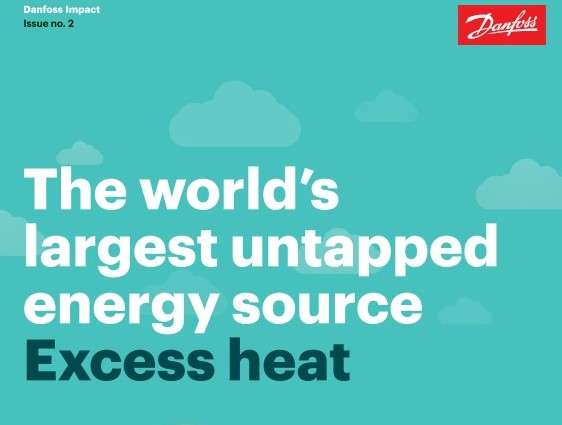New White Paper From Danfoss: “U.S. is sitting on a gold mine of excess heat”

According to new data from multi-national engineering group, Danfoss, excess heat is the world’s largest untapped source of energy and yet little of its potential is being utilized, especially in the United States.
Astrid Mozes, President, Regions, for Danfoss says the US is “sitting on a gold mine of excess heat” and that “policy makers must push for more efficient use of the vast amounts of wasted energy in the form of excess heat.” A new whitepaper details how it would give a productivity boost to the world’s economy, lower energy prices for consumers and businesses and accelerate the green transition.
A new whitepaper from Danfoss, the multi-national engineering group, highlights the vast untapped potential of excess heat as a source of energy and calls on policy makers across the world, including the United States, to accelerate the use of excess heat across all sectors.
Every time an engine or machine runs, it generates heat. Anyone who has felt the warmth behind their refrigerator recognizes that. The same is true on a larger scale in supermarkets, data centers, factories, wastewater facilities, subway stations and commercial buildings.
Excess heat can be reused to supply a factory with heat and warm water or exported to neighboring homes and industries through a district energy system which supplies heat to consumers via a network of underground pipes carrying hot water. Such heat networks can cover a large area or even an entire city or supply a small cluster of local buildings. While the US would need to invest in infrastructure and district heating systems, there is low-hanging fruit in universities and hospital campuses to apply this solution now.
According to Astrid Mozes, President, Regions, at Danfoss, recycling heat is not only an overlooked measure in the current energy crisis, but also the next frontier of the green transition in the United States:
“The United States is sitting on a gold mine of excess heat. Excess heat is the world’s largest untapped source of energy and it is all around us. Using gas or electricity for heating is like using a chainsaw to cut butter, as heating can easily be covered by low-value heating sources such as excess heat.
“Despite this incredible opportunity – we have the most data centers in the world – there are very few initiatives pushing for more efficient use of the vast amounts of wasted energy in the form of excess heat. And this is even though we already have the solutions available to harness heat. We urgently need new policy measures to accelerate the use of excess heat across the US, both so that citizens and businesses can benefit from lower energy costs and to ensure we speed up our progress in the green transition and decarbonize our economy. Let’s make it happen,” adds Astrid Mozes.
Utilizing excess heat can replace significant amounts of fossil fuels that are otherwise needed to produce heat. Used this way, excess heat can help stabilize the future electricity grid and thereby ease the transition to a green energy system.
Yet the potential of excess heat is not even close to being utilized and is virtually ignored in policy circles.
Reusing excess heat is energy efficiency in its purest form
The whitepaper, entitled ‘The world’s largest untapped energy source: excess heat’ assesses the potential of excess heat as an efficient energy source. According to the International Energy Agency (IEA), a global push for more efficient use of energy can reduce CO2 emissions by an additional 5 gigatons per year by 2030 compared with current policy settings. A third of the reduction needed in energy-related CO2 emissions this decade must come from improvements in energy efficiency, according to the IEA net zero scenario.
A full implementation of technologies that tap into synergies between different sectors and enable a utilization of excess heat has the potential to save USD 72bn (EUR 67.4 bn) a year once fully implemented in 2050.
“If we are truly going to harness the potential of excess heat we need to change our perspective on it and begin to consider excess heat as an energy resource instead of waste to be disposed of. A global push for higher efficiency can help avoid almost 30 million barrels of oil per day,” says Astrid Mozes.
“One of the first barriers preventing us from reusing excess heat includes the lack of information. But we must also introduce economic incentives, policy measures and prioritization of partnerships between local authorities, energy suppliers and energy sources to help maximize the full potential of excess heat.
Toby Morgan, Senior Manager, Built Environment, Climate Group commented on the potential for excess heat:
“The global energy crisis is a wakeup call to stop wasting energy, and Danfoss is right to call for governments and corporates to seize the enormous potential of excess heat. Now more than ever we need to make better use of the energy we already produce, we simply can’t afford to let it literally escape out the window. Energy efficiency improvements, like capturing and recycling excess heat, are absolutely critical to lower fossil fuel demand and lower bills.”
‘The world’s largest untapped energy source: Excess heat’ is available for download here.
About Danfoss A/S:
Danfoss engineers solutions that increase machine productivity, reduce emissions, lower energy consumption, and enable electrification. Our solutions are used in such areas as refrigeration, air conditioning, heating, power conversion, motor control, industrial machinery, automotive, marine, and off- and on-highway equipment. We also provide solutions for renewable energy, such as solar and wind power, as well as district-energy infrastructure for cities. Our innovative engineering dates back to 1933. Danfoss is family-owned, employing more than 42,000 people, serving customers in more than 100 countries through a global footprint of 95 factories.


